1960s in Western fashion

.jpg)
The 1960s featured a number of diverse trends. It was a decade that broke many fashion traditions, mirroring social movements during the time. In the middle of the decade, culottes, go-go boots, box-shaped PVC dresses and other PVC clothes were popular. The widely popular bikini came into fashion in 1963 after being featured in the musical Beach Party.
Mary Quant popularised the mini skirt, and Jackie Kennedy introduced the pillbox hat,[1] both becoming extremely popular. False eyelashes were worn by women throughout the 1960s, and their hairstyles were a variety of lengths and styles.[2] People were dressing in psychedelic prints, highlighter colors, and mismatched patterns.[3] The hippie movement late in the decade also exerted a strong influence on ladies' clothing styles, including bell-bottom jeans, tie-dye, and batik fabrics, as well as paisley prints.
In the early-to-mid-1960s, the London Modernists known as the Mods were shaping and defining popular fashion for young British men while the trends for both changed more frequently than ever before in the history of fashion and would continue to do so throughout the decade.[4]
Designers were producing clothing more suitable for young adults, which led to an increase in interest and sales.[5]
Early 1960s
High fashion

Until the 1960s, high-profile designers from Paris and London dictated styles worn by people. However, during and after the 1960s young, common people dictated fashion, and designers would attempt to keep up with the trends that they created.
Fashions in the early years of the decade reflected the elegance of the First Lady, Jacqueline Kennedy. In addition to the pillbox hat, women wore Stiletto heel shoes and suits with short boxy jackets, and over-sized buttons. Simple, geometric dresses, known as shifts, were also in style. For evening wear, full-skirted evening gowns were worn; these often had a low décolletage and had close-fitting waists. For casual wear, capri trousers were the fashion for women and girls.
The rise of trousers for women

The 1960s were an age for fashion innovation for women. The early 1960s gave birth to the drainpipe jeans and capri pants, worn by Audrey Hepburn.[6] Casual dress became more unisex, and often consisted of plaid button down shirts worn with slim blue jeans, comfortable slacks, or skirts for the girls. Traditionally, trousers had been viewed by western society as masculine, but in the early years of the decade it had become acceptable for women to wear them everyday. These included Levi Strauss jeans, which had previously been considered blue collar wear. The women’s trousers came in a variety of styles: narrow, wide, below the knee, above the ankle, and eventually mid thigh. These mid-thigh cut trousers evolved around 1969, and became the modern shorts. By adapting men’s style and wearing trousers, women voiced their equality to men.[7]
Mid-1960s


Space Age fashions
Space age happened during the space race era. It is the age of space exploration. The background of it was from the competition between the USA and Soviet Union during the Cold War period (from 1945 to 1991) –––– the missile arms race, the product of the World War II, Nuclear weapon, one of the most significant examples, and known for its dynamic destruction the serious consequence if being used. Designers, however, seemed to not promote the negative side, but the energetic and technical improvements of the era.[8] It may due to the hope of a better future.[8] Despite the Nuclear weapons and other social issues, there was a futuristic style of design which was inspired by the space exploration and started to pop up from the late 1950s, and escalated in the 1960s.
In the 1960s, synthetic fabrics were used for making garments. Due to the fabric shortage during the Second World War, a lot of synthetic fabrics were invented and introduced in the 1960s. Synthetic fabrics were promoted as cheap, easy to dry, wrinkles, and other benefits that a natural fabric does not have: nylon, corfam, orlon, terylene, lurex and spandex.[9] Because of the fabric feature of synthetic fabric It allows designers to design garment that has bold shape and plastic texture.
The 1960s had many different varieties. For example, the mini dress was usually A-line in shape or a sleeveless shift. In spring 1964, French designer André Courrèges introduced the "space look", with trouser suits, white boots, goggles, and box-shaped dresses whose skirts soared three inches above the knee. The go-go boots were one of the items that presented in the collection, and became one of the must-have item for go-go girls during the sixties.[10] These were mainly designed in fluorescent colors and shiny fabrics such as PVC and sequins.[11] New materials other than cloth (such as polyester and PVC) started to become more popular as well. André Courrèges also inspired designers later that categorized into the space age fashion as well, or in other words, they all together became the space age fashion.[10] One of the well-known space age designer is Pierre Cardin, an Italian born fashion designer,[12] designed streetwear collections with a combination of an avant-garde approach. His famous space age looks are the, helmets, short tunics, and googles [12] Another designer, Paco Rabanne was known for his “12 Unwearable Dresses in Contemporary Materials” collection back to 1966,[8] which was decorated with chain mail, aluminum and plastic and sewed into boxes on the garments [13](Kennedy, 2013). They all together compromise the space age look with boxy shapes, thigh lengths hemline, and bold shaped accessories.[10]
A timeless fashion piece : Miniskirt
After designer Mary Quant introduced the mini skirt in 1964 (although André Courrèges also claimed that he had the credit of inventing the miniskirt), fashions of the 1960s were changed forever. The definition of A miniskirt is the hemline generally between 6 to 7 inches above the knees (earliest direct reference to the miniskirt came from Wyoming newspaper The Billings Gazette, describing the miniskirt as a controversial item in production in Mexico City). The earliest period appeared during ancient era, human beings only wrapped a short fabric around their hips for their daily business: hunting, building etc. Later on, after the hot fashions following World War II were people tended to wear the full skirt that hit below the knee, miniskirt began appearing in science fiction film like “ Flight to Mars” and “Forbidden Planet” during 1950s. [14]
Mary Quant and Andre Courreges both are well contributed to the invention of miniskirt during the 1960s. Mary Quant, A British designer, as one of the pioneers of miniskirt during 1960’s and she named the skirt after her favorite car, the Mini Cooper. She was one of the most business -savvy designers of a new generation. She introduced her design in the mid-60s at her London boutique, Bazaar—a boutique to offer cheap clothes designed specifically for young people. One of her concepts of this innovative idea is “ We wanted to increase the availability of fun for everyone. We felt that expensive things were almost immoral and the New Look was totally irrelevant to us.” Miniskirt became popular in London and Paris and created a term called “ Chelsea Look”. [15] Andre Courreges, another French fashion designer who experimenting with hemlines as well in the early 1960s, and he began to show space-age dresses that hit above the knee in late 1964. His designs are more likely to be more structured and sophisticated than Quant’s design. This made the miniskirt more acceptable to the French public, and became more popular as it was not a huge difference from the chic styles they were used to. His clothes represented a couture version of the “Youth-quake” -driven street style, and heralded the arrival of the “moon girl” look. [16]
As the teen culture became stronger, “Youth-quake” appeared in describing the power of young people since it never happened before the 1960s. Before World War II, teenagers were essentially mini adults. They dressed and acted like their parents and many settled down and began raising families when they were young, normally right after high school. Also, many were expected to work and assist their families financially. Therefore, youth culture only appears after World War II when the advancement of many technologies and stricter child labor laws became mainstream. Teenagers during that time gained more time to enjoy their youth. This created a climate where they had a freedom to create their own culture separate from their parents. Teens are soon beginning to establish their own identities and communities with their own views and ideas, breaking away from their parent’s traditions and beliefs. [17]
Baby boom is another factor to push the teen culture to a higher level, teens have more chances of influencing the fashion of the world. The teen fashion became the mainstream during the 1960s because of the fame of The Beatles and people became crazily obsessed with British fashion, culture, it included mini skirts and Mod style with a lot of bright colors. The fabulous “ little girl “ look was introduced to USA —styling with Bobbie Brooks, bows, patterned knee socks and mini skirts. The miniskirt and the "little girl" look that accompanied it reflect a revolutionary shift in the way people dress. Instead of younger generations dressing like adults, they became inspired by childlike dress. [18]
The women’s liberation movement, Second wave feminism makes the miniskirt became popular. Before 1960, female were used to working in factories during World War II, many women soon found they craved a career and life outside the home instead of taking care of kids, doing housework etc.[19] They wanted the same choices, freedoms, and opportunities that were offered to men. Women realized that they wanted to be able to choose what they did with their bodies. Many women decided to postpone starting families in their young age because they wanted to explore the world. Getting married, became an option. The invention of the birth control pill makes the desire became stronger. [20]
There were many different examples to show that mini skirt was the hot item for the celebrity or publicity, it included: 1960, Twiggy, It girl; 1965, Model Jean Shrimpton, she was wearing mini skirt attended an event in the Melbourne Cup Carnival in Australia; 1967, Goldie Hawn, she appeared in “Laugh In” debuted on Tv with her mini skirt and, 1968, Jackie Kennedy, was wearing a short white pleated Valentino dress when she married Aristotle Onassis etc.
The Single Girl
.jpg)
Fashion photography in the 1960s represented a new feminine ideal for women and young girls: the Single Girl. The 1960s photography was in sharp contrast to the models of the 1920s, which photographers carefully posed for the camera, and portrayed as immobile. The Single Girl represented ‘movement’. She was young, single, active, and economically self-sufficient. To represent this new Single Girl feminine ideal, many 1960s photographers shot models outside, often having them walk or run in fashion shoots. Models in the 1960s now promoted sports wear which reflected the modern fascination with speed, and the quickening pace of the 1960s urban life. Although the Single Girl was economically, socially and emotionally self-sufficient, the ideal body form; that of the adolescent was difficult for many to achieve. Therefore, women were constrained by diet restrictions that seemed to contradict the sense of the empowered 1960s Single Girl.[21]
Fashion photographers also photographed the Single Girl wearing business wear, calling her the Working Girl. The Working Girl motif represented another shift for the modern, fashionable woman. Unlike earlier fashionable periods, when formal evening gowns and the European look trended, the 1960s Working Girl popularized daywear and "working clothing". Now, new ready to wear lines replaced individualized formal couture fashion. The Working Girl created an image of a new, independent woman who has control over her body.[21]
Mod and British Invasion influences
The leaders of mid-1960s style were the British. The Mods (short for Modernists) were characterized by their choice of style different from the 1950s and adopted new fads that would be imitated by many young people. Mods formed their own way of life creating television shows and magazines that focused directly on the lifestyles of Mods.[1] British rock bands such as The Who, The Small Faces, the Beatles, and The Kinks emerged from the Mod subculture. The Mods were known for the Modern Jazz they listened to as they showed their new styles off at local cafes. They worked at the lower end of the work force, usually nine to five jobs leaving time for clothes, music, and clubbing.[1] It was not until 1964 when the Modernists were truly recognized by the public that women really were accepted in the group. Girls had short, clean haircuts and often dressed in similar styles to the male Mods.[4] The Mods' lifestyle and musical tastes were the exact opposite of their rival group known as the Rockers. The rockers liked 1950s rock-and roll, wore black leather jackets, greased, pompadour hairstyles, and rode motorbikes. The look of the Mods was classy; they mimicked the clothing and hairstyles of high fashion designers in France and Italy; opting for tailored suits, which were topped by anoraks that became their trademark. They rode on scooters, usually Vespas or Lambrettas. The Mods dress style was often called the City Gent look. The young men [22] incorporated striped boating blazers and bold prints into their wardrobe.[23] Shirts were slim, with a necessary button down collar accompanied by slim fitted pants.[4] Levi's were the only type of jeans worn by Modernists. Mod girls wore very very short miniskirts, tall, brightly colored go-go boots, monochromatic geometric print patterns such as houndstooth, and tight fitted, sleeveless tunics. Flared trousers and bellbottoms appeared in 1964 as an alternative to capri pants, and led the way to the hippie stage introduced in the 1960s. They were usually worn with chiffon blouses, polo-necked ribbed sweaters or tops that bared the midriff. These were made in a variety of materials including heavy denims, silks, and even elasticated fabrics.[24] Variations of polyester were worn along with acrylics.[4] A popular look for females was the suede mini-skirt worn with a French polo-neck top, square-toed boots, and Newsboy cap or beret. This style came back in the early 2000s (decade).
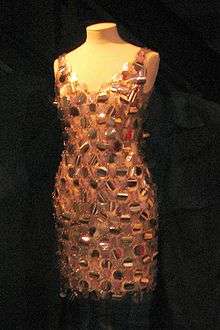

Carnaby Street and Chelsea's Kings Road were virtual fashion parades. In 1966, the space age was gradually replaced by the Edwardian, with the men wearing double-breasted suits of crushed velvet or striped patterns, brocade waistcoats, shirts with frilled collars, and their hair worn below the collar bone. Rolling Stones guitarist Brian Jones epitomised this "dandified" look. Women were inspired by the top models of the day which included Twiggy, Jean Shrimpton, Colleen Corby, Penelope Tree, and Veruschka. Velvet mini dresses with lace-collars and matching cuffs, wide tent dresses and culottes had pushed aside the geometric shift. False eyelashes were in vogue, as was pale lipstick. Hemlines kept rising, and by 1968 they had reached well above mid-thigh. These were known as "micro-minis". This was when the "angel dress" made its appearance on the fashion scene. A micro-mini dress with a flared skirt and long, wide trumpet sleeves, it was usually worn with patterned tights, and was often made of crocheted lace, velvet, chiffon or sometimes cotton with a psychedelic print such as those designed by Emilio Pucci. The cowled-neck "monk dress" was another religion-inspired alternative; the cowl could be pulled up to be worn over the head. For evening wear, skimpy chiffon baby-doll dresses with spaghetti-straps were the mode as well as the "cocktail dress", which was a close-fitting sheath, usually covered in lace with matching long sleeves.[25] Feather boas were occasionally worn.
The look of corsets, seamed tights, and skirts covering the knees had been abolished. The idea of buying urbanized clothing, which could be worn with separate pieces, was intriguing to women of this era in comparison to previously only buying specific outfits for certain occasions.[26]
For daytime outerwear, short plastic raincoats, colourful swing coats and dyed fake-furs were popular for young women. In 1966, the Nehru jacket arrived on the fashion scene, and was worn by both sexes. Suits were very diverse in color but were for the first time ever fitted and very slimming. Waistlines for women were left unmarked and hemlines were getting shorter and shorter.
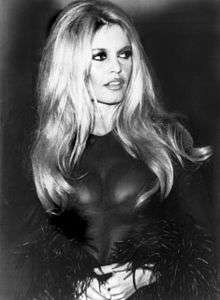
Footwear for women included low-heeled sandals and kitten-heeled pumps, as well as the trendy white go-go boots. Shoes, boots, and handbags were often made of patent leather or vinyl. The Beatles wore elastic-sided boots similar to Winkle-pickers with pointed toes and Cuban heels. These were known as "Beatle boots" and were widely copied by young men in Britain.
Starting in 1967, the Mod culture began to change musically and the culture altered to a more laid back hippie or Bohemian style. Hosiery manufacturers of the time like Mary Quant (who founded Pamela Mann Legwear) combined the "Flower Power" style of dress and the Pop Art school of design to create fashion tights that would appeal to a female audience that enjoyed psychedelia.[27]
In the USSR during the mid to late 1960s, Mods and Hippies were nicknamed Hairies for their mop top hair.[28] As with the earlier Stilyagi in the 1950s, young Russian men who dressed this way were ridiculed in the media, and sometimes forced to get their hair cut in police stations.[29]
Late 1960s

The hippie subculture
The late 1960s produced a style categorized of people who promoted sexual liberation and favored a type of politics reflecting "peace, love and freedom". Ponchos, moccasins, love beads, peace signs, medallion necklaces, chain belts, polka dot-printed fabrics, and long, puffed "bubble" sleeves were additional trends in the late 1960s.
Both men and women wore frayed bell-bottomed jeans, tie-dyed shirts, workshirts, Jesus sandals, and headbands. Women would often go barefoot, and some went braless. The idea of multiculturalism also became very popular; a lot of style inspiration was drawn from traditional clothing in Nepal, India, Bali, Morocco and African countries. Because inspiration was being drawn from all over the world, there was increasing separation of style; though clothing pieces often had similar elements and created similar silhouettes, there was no real "uniform".[30]
Fringed buck-skin vests, flowing caftans, the "lounging" or "hostess" pajamas became popular. "Hostess" pajamas consisted of a tunic top over floor-length culottes, and were usually made of polyester or chiffon.
Long maxi coats, often belted and lined in sheepskin, appeared at the close of the decade. Animal prints were also popular for women in the autumn and winter of 1969. Women's shirts often had transparent sleeves. Psychedelic prints, hemp and the look of "Woodstock" came about in this generation.
By 1969, psychedelia had begun to influence mainstream menswear, with the pale, toned business suits being replaced with Bohemian Carnaby Street creations that included velvet or brocade double breasted suits, frilly shirts, cravats, wide ties and trouser straps, leather boots, and even collarless Nehru jackets. The slim neckties of the early 60s were replaced with Kipper ties exceeding five inches in width, and featuring crazy prints, stripes and patterns.[31]
Asian fashions
In general, urban Indian men imitated Western fashions such as the business suit. This was adapted to India's hot tropical climate as the Nehru suit, a garment often made from khadi that typically had a mandarin collar and patch pockets. From the early 1950s until the mid 60s, most Indian women maintained traditional dress such as the gagra choli, saree, and churidar. At the same time as the hippies of the late 60s were imitating Indian fashions, however, some fashion conscious Indian and Ceylonese women began to incorporate modernist Western trends.[32] One particularly infamous fad combined the miniskirt with the traditional saree, prompting a moral panic where conservatives denounced the so-called "hipster saree"[33] as indecent.
Hairstyles of the 1960s
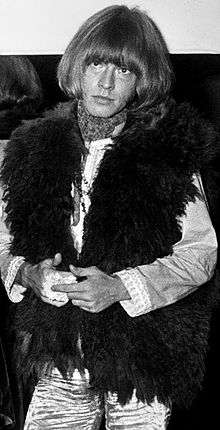
The most important change in hairstyles during this period was that men and women wore styles that resembled each other. It was the new fashion for women used to cut their hair short and close to their heads.[34] Head coverings changed dramatically towards the end of the decade as men's hats went out of style, replaced by the bandanna, if anything at all. As men let their hair grow long, the Afro became the hairstyle of choice for African Americans. This afro was not just a fashion statement but also an emblem of racial pride. They started to believe that by allowing their hair to grow in its nature state without chemical treatments, they would be accepting their racial identities.[35] Mop-top hairstyles were most popular for white and Hispanic men, beginning as a short version around 1963 through 1964, developing into a longer style worn during 1965–66, eventually evolving into an unkempt hippie version worn during the 1967–69 period which continued in the early 1970s. Facial hair, evolving in its extremity from simply having longer sideburns, to mustaches and goatees, to full-grown beards became popular with young men from 1966 onwards. Women's hair styles ranged from beehive hairdos in the early part of the decade to the very short styles popularized by Twiggy and Mia Farrow just five years later to a very long straight style as popularized by the hippies in the late 1960s. Between these extremes, the chin-length contour cut and the pageboy were also popular. The pillbox hat was fashionable, due almost entirely to the influence of Jacqueline Kennedy, who was a style-setter throughout the decade. Her bouffant hairstyle, described as a "grown-up exaggeration of little girls' hair", was created by Kenneth.[36][37] Hair styles were very big and used a large quantity of hair spray (hence the musical Hairspray), somewhat like ours today.
Image gallery
A selection of images representing the fashion trends of the 1960s:
-

First Lady Jacqueline Kennedy wearing a red wool dress with matching jacket. She was a fashion icon in the early 1960s.
-
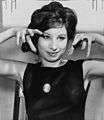
Singer and actress Barbra Streisand in 1962 wearing a top with a crew-neck. Her hair is teased at the crown.
-

Graciela Borges, Argentine fashion icon of the 1960s, wearing a fur coat, bouffant hair and winged eye liner.
-

Audrey Hepburn in a scene from the comic thriller Charade dressed by Givenchy 1963.
-

Dress worn by Anneke Grönloh for the 1964 Eurovision Song Contest 1964
-
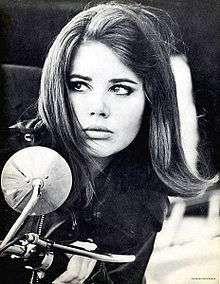
Colleen Corby, teenaged supermodel of the mid-1960s.
-

In 1965 sleeveless shift dresses were popular with women.
-
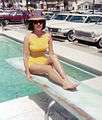
Young woman in Florida, 1965.
-
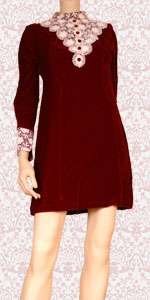
A velvet minidress from 1965.
-
.jpg)
American girl wearing a mini skirt and patterned tights, 1966.
-

Young woman wears her hair in a pageboy flip, 1967.
-

Woman at a Singapore zoo, 1967. Note her Pucci-style print dress.
-
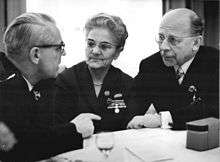
East German politicians wearing horn rimmed glasses, cat eye glasses, and wire rimmed glasses, late 1960s.
-

Family photograph taken in Los Angeles, California, 1968. The man is wearing a medallion necklace.
-

Lars Jacob wears the popular "dandified" male fashions in Austria in 1967.
-

Young girl wearing a mini dress and white go-go boots, 1968.
-

In the late 1960s, brides often wore white mini wedding dresses.
-
Two men at the Woodstock Festival, 1969
-

Girl in late 1969 wearing a tiger-print mini jumper dress and matching beret.
-

Boy with a mop top hair cut, 1969.
-

Singer Maria Muldaur in 1968, wearing a gypsy-style kerchief and hoop earrings.
See also
Fashion designers
Style icons
- Marella Agnelli
- Anouk Aimée
- Brigitte Bardot
- Jane Birkin
- Amanda Burden
- Claudia Cardinale
- Cher
- Consuelo Crespi
- Julie Christie
- Catherine Deneuve
- Farah Diba
- Faye Dunaway
- Jane Fonda
- Dolores Guinness
- Gloria Guinness
- Audrey Hepburn
- Jacqueline Kennedy
- Sophia Loren
- Babe Paley
- Lee Radziwill
- Vanessa Redgrave
- Jacqueline de Ribes
- Diana Ross
- Diana Rigg
- Edie Sedgwick
- Nancy Sinatra
- Queen Sirikit
- Sharon Tate
- Raquel Welch
- Natalie Wood
- Jayne Wrightsman
Supermodels
Fashion photographers
Teenage subcultures
- Greaser subculture
- Mod subculture
- Soc subculture
- Surfer
- Beatnik
- Hippie
- Rude Boy
- Skinhead
- Black Panthers
Other
References
- 1 2 3 "Braggs, Steve, and Diane Harris. 60s Mods.". Retrowow.co.uk. March 1, 2009.
- ↑ Rich Candace (2010–2015). "Makeup". Fiftiesweb.com.
- ↑ Dir. Vidcat1. Redtube (February 13, 2007). "Vintage Fashion Newsreels 1960s". Youtube.com. Retrieved March 27, 2009.
- 1 2 3 4 "Braggs, Steve, and Diane Harris. 60s Mods". Retrowow.co.uk. March 1, 2009.
- ↑ "Goodwin, Susan, and Becky Bradley. American Cultural History: 1960–1969". Kingwood College Library. Kclibrary.lonestar.edu. March 1, 2009. Archived from the original on March 1, 2009.
- ↑ "Audrey Hepburn's style hits". Harper's BAZAAR. 2014-05-02. Retrieved 2016-02-08.
- ↑ Deslandres, François Boucher ; with a new chapter by Yvonne (1987). 20,000 Years of Fashion : the history of costume and personal adornment (Expanded ed.). New York: Harry N. Abrams. ISBN 0-8109-1693-2.
- 1 2 3 Pavitt, Jane (2008). Fear and fashion in the Cold War. London: V&A Pub. p. 60. ISBN 9781851775446.
- ↑ Walford, Johnathan (2013). Sixties fashion: From less is more to youthquake. London: Thames & Hudson. p. 110. ISBN 9780500516935.
- 1 2 3 Yotka, Steff. "Remembering André Courrèges". Vogue. Retrieved 2016-05-19.
- ↑ Fashion From Ancient Egypt To The Present Day, by Mila Contini, p. 317
- 1 2 "Pierre Cardin". Encyclopaedia Britannica. Encyclopaedia Britannica. 2016. Retrieved 2016-05-18.
- ↑ Kennedy, Alicia (2013). Fashion design, referenced: A visual guide to the history, language, and practice of fashion. Gloucester. MA: Rockport. ISBN 978-1592536771.
- ↑ Parks, C. (2015, March 23). The Miniskirt: An Evolution From The '60s To Now. Retrieved October 30, 2016, from http://www.huffingtonpost.com/2015/03/23/mini-skirt-evolution_n_6894040.html
- ↑ Paula Reed. (2012). In Fifty fashion looks that changed the 1960s (pp. 30-31). England: Alison Starling.
- ↑ Koda, H. (2010). 100 dresses: The Costume Institute , The Metropolitan Museum of Art. S.l.: Yale University Press.
- ↑ Blackman, C. (2012). 100 years of fashion. London: Laurence King Pub.
- ↑ Nectara , J ( 2012, July 13 ).The Miniskirt – A Short History. Retrieved October 30, 2016, from http://www.fashionavecpassion.com/the-miniskirt-a-short-history/
- ↑ Bourne, L. (2014). A history of the Miniskirt : How fashion’s most daring hemline came to be. Retrieved October 30, 2016, from http://stylecaster.com/history-of-the-miniskirt/
- ↑ Niara. (2016, January 9). Aesthetics and Activism : The history of miniskirt. Retrieved October 30, 2016, from http://www.collegefashion.net/inspiration/the-history-of-the-miniskirt/
- 1 2 Radner, Hilary (2001). "Embodying the Single Girl in the 1960s". In Joanne Entwistle and Elizabeth B. Wilson. Body Dressing. Bloomsbury Academic. pp. 183–197. ISBN 1859734448.
- ↑ Pendergast, Tom and Sarah (2004). Fashion, Costume and Culture. MI, USA: Thomson Gale. p. 895. ISBN 0-7876-5422-1.
- ↑ "For Your Love: The Best of the Sixties British Invasion". Rolling Stone. Retrieved 2016-02-08.
- ↑ Tarrant, Naomi (1994). The Development of Costume. London: Routledge. p. 88.
- ↑ Contini, p. 317
- ↑ Belinda T. Orzada (2000-01-10). "Orzada, Belinda T. "Fashion Trends and Cultural Influences 1960-present." Twentieth Century Design: Ethnic Influences. 7 Oct. 1998. University of Delaware. 10 Apr. 2009". Udel.edu. Retrieved 2012-08-11.
- ↑ Hosiery Trends Over The Decades
- ↑ 1965 revolutionary music
- ↑ The Guardian
- ↑ Miles, Barry (2004). Hippie. Sterling. ISBN 1402714424.
- ↑ Marshall, Peter (February 27, 2009). "Peacock Revolution: Informal Counterculture". Black-tie-guide 2009.
- ↑ Eastern miniskirt
- ↑ Ceylonese mini saree
- ↑ Pendergast, Tom and Sarah (2004). Fashion, Costume and Culture. MI, USA: Thomson Gale. p. 935. ISBN 0-7876-5422-1.
- ↑ Pendergast, Tom and Sarah (2004). Fashion, Costume and Culture. MI, USA: Thomson Gale. pp. 937–938. ISBN 0-7876-5422-1.
- ↑ Collins, Amy Fine (1 June 2003). "It had to be Kenneth.(hairstylist Kenneth Battelle)(Interview)". Vanity Fair. Retrieved 3 December 2012.
- ↑ Wong, Aliza Z. (2010). Julie Willett, ed. The American beauty industry encyclopedia: Hairstylists, Celebrity. Santa Barbara, Calif.: Greenwood. pp. 151–154. ISBN 9780313359491.
External links
| Wikimedia Commons has media related to 1960s fashion. |
- "1960s Fashion and Textiles collection". Fashion, Jewellery & Accessories. Victoria and Albert Museum. Retrieved 2007-06-08.
- "60s Fashion in the Round". Fashion, Jewellery & Accessories. Victoria and Albert Museum. Archived from the original on 26 November 2007. Retrieved 2007-12-09.
- "1960s - 20th Century Fashion Drawing and Illustration". Fashion, Jewellery & Accessories. Victoria and Albert Museum. Retrieved 2011-04-03.
- "Swing Fashion – Coats and Jackets". Swing Fashion. Fashion Ode. Archived from the original on 2015-01-12. Retrieved 2014-12-23.
